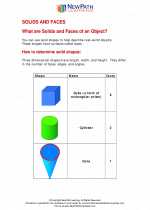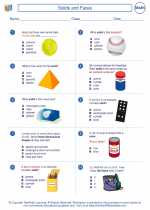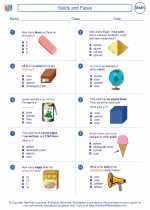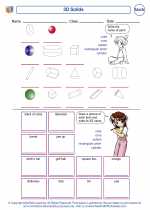Prism
A prism is a three-dimensional geometric shape that has two parallel and congruent polygonal bases connected by parallelogram faces. The most common type of prism is a right prism, where the lateral faces are perpendicular to the bases. Prisms are named based on the shape of their bases, such as a rectangular prism, triangular prism, or hexagonal prism.
The volume of a prism can be calculated using the formula V = B * h, where V is the volume, B is the area of the base, and h is the height of the prism. The surface area of a prism can be found by adding the areas of all its faces, which includes the area of the two bases and the areas of the lateral faces.
Prisms are commonly found in everyday objects, such as buildings, boxes, and containers. Understanding the properties of prisms is important in geometry and can be applied to real-world problems involving volume and surface area.
.◂Math Worksheets and Study Guides Third Grade. Solids and Faces

 Worksheet/Answer key
Worksheet/Answer key
 Worksheet/Answer key
Worksheet/Answer key
 Worksheet/Answer key
Worksheet/Answer key
 Worksheet/Answer key
Worksheet/Answer key
 Worksheet/Answer key
Worksheet/Answer key
